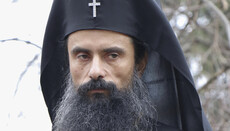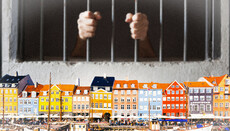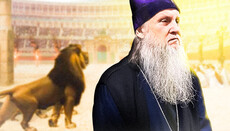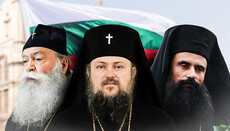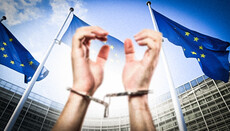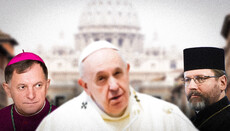The visit of the Phanar head to Rome: what can humanity expect?
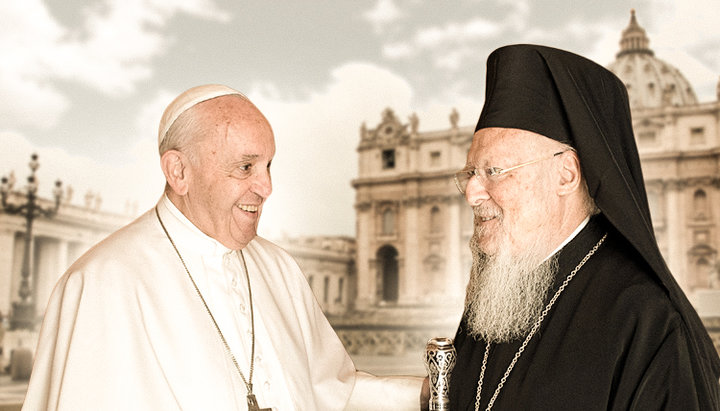
On October 19-22, 2020, during the visit of the Phanar head to Rome, statements indicating that we are living in the era of the creation of a new religion were made.
On October 19, 2020, Patriarch Bartholomew of Constantinople travelled to Rome to take part in a number of events organized by the Roman Catholic Church.
Immediately on arrival, the head of the Phanar participated at an ecumenical prayer service (moreover, it was he who was given the honour to start and finish it) at the Roman Catholic Basilica of Santa Maria in Trastevere.
On October 20, 2020, already at the Basilica of Santa Maria in Aracoeli, located at the top of the Capitoline Hill in Rome, an ecumenical prayer for peace took place, and on the evening of October 21, Patriarch Bartholomew became an Honorary Doctor of Pontificia Università Antonianum.
Meeting of Pope Francis and Pat. Bartholomew: signs and symbols
The next day, October 22, a meeting between Pope Francis and the head of the Phanar took place in Vatican City, which, according to available information, lasted 50 minutes. The Patriarch said that such a long talk is due to the fact that “the two brothers have much to tell each other and share”. It is interesting that at the very beginning of the conversation with the Roman pontiff, the Ecumenical Patriarch pointed out with satisfaction the photo that Pope Francis has on his desk. It is a photograph of the two of them, which, according to the official website of the Patriarchate of Constantinople, "the Pope has placed where he holds meetings with the highest figures". The gifts exchanged between the parties are also noteworthy. In particular, Patriarch Bartholomew presented the Pope with an icon of St. Martha of Bethany, made by the monks of Mount Athos, and Pope Francis gave the Phanar head a plaque depicting the Holy Apostles Peter and Andrew embracing each other.
The symbolism of these two gifts is quite clear. Saint Martha of Bethany, the sister of Saint Lazarus, is known for the fact that during Christ's visit to their home, she took care of the Lord's food and asked Him to request her sister Mary to help her. To which Christ replied: "Martha, you are worried and upset about many things. But only one thing is necessary. Mary (who listened attentively to the Saviour, instead of taking care of the table – Ed.) has chosen the good portion, and it will not be taken away from her. Chose the good part that will not be taken away from her." Thus, giving the icon of St. Martha to the Pope of Rome, Patriarch Bartholomew seemed to be hinting at his social service, and at the same time, at the preparation of a common meal for all who wish to meet Christ. Obviously, the head of the Phanar sees, first of all, the Orthodox and Catholics as the participants in this meal.
“The two brothers have much to tell each other and share.”
Patriarch Bartholomew about his meeting with Pope Francis
The image of the apostles embracing each other, which the Pope presented to Patriarch Bartholomew, also alludes to this future community. After all, everyone remembers perfectly well that the Apostle Peter is considered the patron saint of the See of the Roman archbishops, and the Apostle Andrew – of the archbishops of Constantinople, respectively. In addition, last year, Pope Francis made another gesture, which, according to the Phanariot Archbishop Job (Getcha), should be taken as a prophetic indication of the unity of Rome and Constantinople – he presented the Phanar with the relics of the Apostle Andrew.
Therefore, the context and symbolic meaning of these gifts is clear – to emphasize that the movement towards the communion of Catholics and Orthodox Christians continues and intensifies.
However, it is possible that in the future Istanbul and Rome will allow the possibility of participation in their union of representatives of other religious movements. Of course, now it seems like complete fantasy. But let's remember that not so long ago the pagan goddess Pachamama was "catechized" in the Vatican, and the top leadership of the Roman Catholic Church not only maintains contacts with Islam but also takes part in Muslim holidays. The Pope himself signs with the Supreme Imam of Cairo a joint declaration "Human brotherhood for world peace and common coexistence". In addition, in Rome, the aforementioned ecumenical prayer for peace was attended by pagans, representatives of Islam, and Buddhists.
Today it is already quite appropriate to ask the question not about whether a certain syncretic religion will be created but about the terms on which its creation can be carried out. And it seems to us that the answer to this question can be found in the words of both Patriarch Bartholomew and the Pope said these days.
Other faiths – the wealth of the sons of God?
The main reason for Patriarch Bartholomew's stay in Rome and the Vatican was his participation in the so-called International Prayer for Peace Meeting "No one is Saved Alone – Peace and Brotherhood".
In the event poster, along with the Ecumenical Patriarch of Constantinople, other "meeting" participants were also indicated: Pope Francis, the head of the European Commission Ursula von der Leyen, Italian President Sergio Mattarella, the founder of the Community of Saint Egidio Andrea Riccardi and Chief Rabbi of France Haїm Korsia.
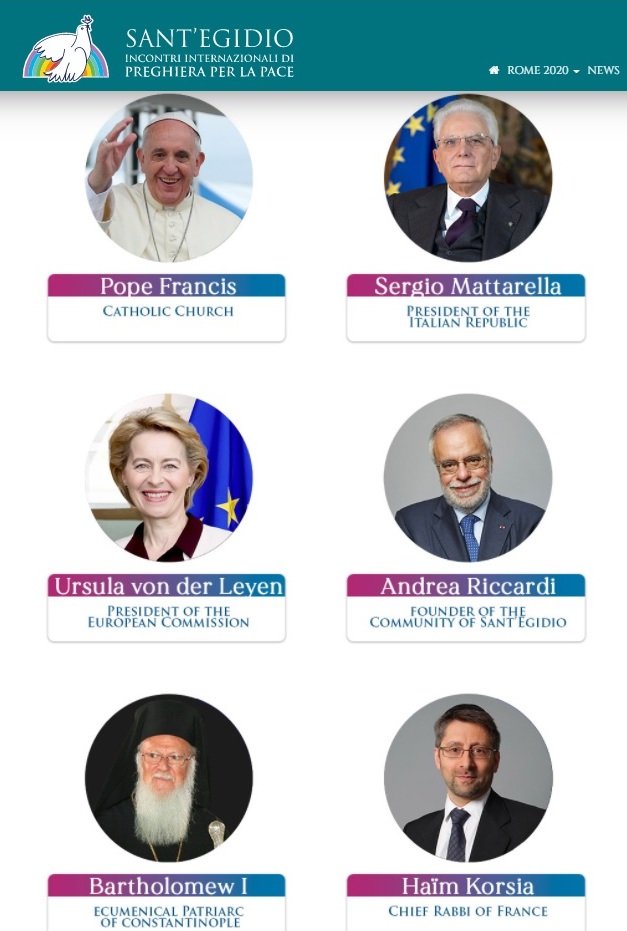
The event was initiated and hosted by the Catholic Community of Saint Egidio. This organization positions itself as a secular charitable and peacemaking organization, but, in fact, now it is most actively involved in the development of dialogue between Catholics and Orthodox Christians, as well as inter-Christian and inter-religious dialogue. For more than 30 years, the "Community" has been gathering representatives of Christian Churches and major world religions, political and cultural figures for the "Prayer for Peace", which should testify to the common values and aspirations of all people on earth.
It is hardly worth discussing the expediency of the participation of Orthodox hierarchs in such events. Suffice it to recall the 10th apostolic canon, which prohibits prayer with heretics (“If any one shall pray, even in a private house, with an excommunicated person, let him also be excommunicated.”). And the argument that we will be misunderstood if the representatives of our Church do not attend such a "prayer" is completely inappropriate. After all, you can pray in your own church, not in the square.
It is hardly worth discussing the expediency of the participation of Orthodox hierarchs in joint prayers with representatives of other confessions. Suffice it to recall that “If any one shall pray, even in a private house, with an excommunicated person, let him also be excommunicated”.
The problem is that participation in the initiatives of the "Community of Saint Egidio" leads the Orthodox Church not only to the devaluation of the doctrine of salvation (the only true one), but also to an alliance with heretics, apostates, and in the near future, with pagans – a union based on "universal human values" that are constantly changing rather than the Church's teaching about Christ. The road to this union is a vague, amorphous understanding of "love" and "friendship", on which the "new Сhurch" and later the "new religion" will be built.
Religion at the service of peace and fraternity
For example, during his speech at the ecumenical prayer service, the head of the Phanar stated that other religions are "the wealth of the sons of God". Besides, addressing the participants in the prayer service, among whom were the majority of Catholics, Patriarch Bartholomew did not say a word about repentance and did not even hint at calling on the representatives of the RCC to rethink their erroneous understanding of the dogmas of the Church. Instead, he focused on calling them to "friendship": “Tonight, beloved brothers and sisters, let us share together the taste of this friendship and of this love that He has offered us in abundance.... "
Apparently, for Patriarch Bartholomew, his own perception of "friendship" and "love" is the path that leads to unity with Catholics: “Looking into your eyes, looking at the eyes that shine in this Community, we can see the abundant fruit awaited by God and we rejoice in it because we perceive the love of Christ because we live the friendship of being all his disciples because we all walk towards our transfiguration in Him." In general, the entire speech of Bartholomew is all about love, without a mention of repentance. And, in principle, the Pope said the same a little later.
Speaking at the Santa Maria in Aracoeli Basilica, the pontiff said, "Love alone is the way to full communion between us." What does Francis mean by this word? He explains: “The more we are attached to the Lord Jesus, the more open and ‘universal’ we will be because we will feel responsible for others. And the other will be the way to save oneself: every other, every human being, whatever his history and belief." It turns out that the path to salvation lies in social service, in serving others, in a feeling of openness and “universality” towards everyone.
On the same day, immediately after praying at the Santa Maria in Aracoeli Basilica, the Pope spoke in Piazza del Campidoglio to declare that “we must instead recognize the fruitful steps in the dialogue between religions. It is a sign of hope that encourages us to work together as brothers: as brothers." According to him, "religions are at the service of peace and fraternity".
Undoubtedly, any religious person stands for peace. In this sense, it is Christianity that is the most peaceful religion and only in Christianity are peacemakers called blessed. But can striving for peace be called the main goal of religion in general and Christianity in particular?
In addition, the Pope is confident that “No people, no social group can alone achieve peace, good, security and happiness. ... We remember that no one can be saved alone, that we can only be saved together. Fraternity, which springs from the awareness of being a single humanity, must penetrate the life of peoples, communities, rulers, international fora. Thus, the awareness that we can only be saved together will rise, by meeting, negotiating, giving up fighting, reconciling, moderating the language of politics and propaganda, developing concrete paths for peace."
The Pope's Encyclical – a crown of social doctrine?
In other words, for the Pope, the main task of religion is to create the necessary conditions for a happy life on earth. The word "salvation" is used by him exclusively in the biological sense – as the maximum extension of the years spent by man on earth. He does not talk about the posthumous fate of a person, does not talk about how to save his/her soul, does not say that this is the purpose of the Church and the Christian faith as a whole. No, only about earthly good and earthly fraternity. Is it, therefore, any surprise that for such a position Francis is praised by the Masons?
The word "salvation" is used by him exclusively in the biological sense – as the maximum extension of the years spent by man on earth.
Another thing is strange – that such a position finds full support from Patriarch Bartholomew, who considers the last encyclical of the Pope "Fratelli Tutti" ("All people are brothers" – Ed.) "the crown of social doctrine".
However, in the opinion of the hierarch of the Russian Church, Bishop Savva (Tutnov), the red line of the encyclical is “social globalism”. According to the apt remark of Bishop Savva, "Fratelli Tutti" is "in general, an interesting, far from indisputable political treatise with a formal reference to the Gospel and adapted to modern left-liberal expectations, new dreams that ‘we will build a just world’".
Agreeing with this characteristic of the Russian hierarch, we add that this papal document should be perceived in the light of everything that is happening today – the pandemic, the migration policy of the European Union (it is no coincidence that the head of the European Commission was invited to the "Prayer for Peace"), protest movements in the USA and Europe, statements about support for LGBT people. All this together really creates a new social doctrine of the Roman Catholic Church, in many respects different from the one that the Church has preached for millennia.
Therefore, it is possible to call it a “crown” only in case of rejection of the axiom, according to which, the mission of the Church is to bring a person into the Kingdom of God, into unity with Christ. And it is very sad that the Orthodox patriarch of the once glorious city of great Constantine forgets about this.
However, most likely he does not forget but participates in a "project" whose main goal is to create a syncretic religion. The basis for it will be precisely that understanding of "love" and "fraternity", which was voiced these days in Rome. According to it, religion is nothing more than a social appendage designed to help improve the life of society. And the fact that the demands of society are constantly changing suggests that this syncretic religion will also change – both in terms of language (remember the words of the Pope about “moderating language”) and in terms of form. Change until it becomes clear that humanity must bow to its "saviour".
The one that will come “instead of” Christ.
